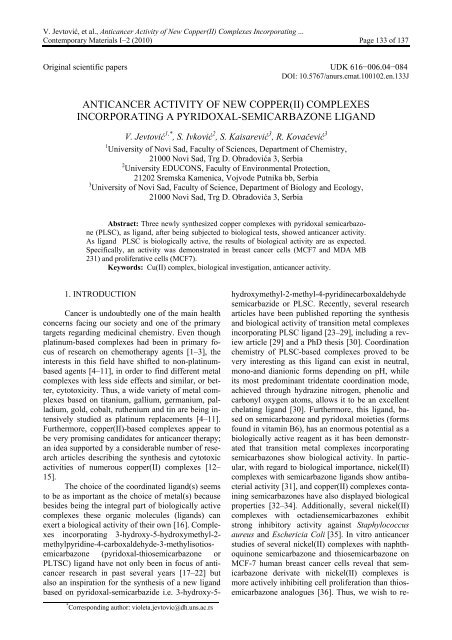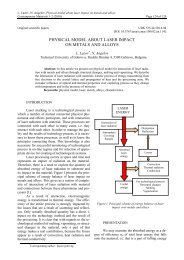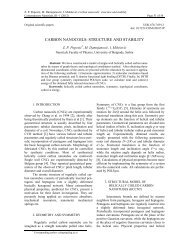Anticancer Activity of New Copper(II) Complexes Incorporating
Anticancer Activity of New Copper(II) Complexes Incorporating
Anticancer Activity of New Copper(II) Complexes Incorporating
You also want an ePaper? Increase the reach of your titles
YUMPU automatically turns print PDFs into web optimized ePapers that Google loves.
V. Jevtović, et al., <strong>Anticancer</strong> <strong>Activity</strong> <strong>of</strong> <strong>New</strong> <strong>Copper</strong>(<strong>II</strong>) <strong>Complexes</strong> <strong>Incorporating</strong> ...<br />
Contemporary Materials I−2 (2010) Page 133 <strong>of</strong> 137<br />
Original scientific papers<br />
UDK 616−006.04−084<br />
DOI: 10.5767/anurs.cmat.100102.en.133J<br />
ANTICANCER ACTIVITY OF NEW COPPER(<strong>II</strong>) COMPLEXES<br />
INCORPORATING A PYRIDOXAL-SEMICARBAZONE LIGAND<br />
V. Jevtović 1,* , S. Ivković 2 , S. Kaisarević 3 , R. Kovačević 3<br />
1 University <strong>of</strong> Novi Sad, Faculty <strong>of</strong> Sciences, Department <strong>of</strong> Chemistry,<br />
21000 Novi Sad, Trg D. Obradovića 3, Serbia<br />
2 University EDUCONS, Faculty <strong>of</strong> Environmental Protection,<br />
21202 Sremska Kamenica, Vojvode Putnika bb, Serbia<br />
3 University <strong>of</strong> Novi Sad, Faculty <strong>of</strong> Science, Department <strong>of</strong> Biology and Ecology,<br />
21000 Novi Sad, Trg D. Obradovića 3, Serbia<br />
Abstract: Three newly synthesized copper complexes with pyridoxal semicarbazone<br />
(PLSC), as ligand, after being subjected to biological tests, showed anticancer activity.<br />
As ligand PLSC is biologically active, the results <strong>of</strong> biological activity are as expected.<br />
Specifically, an activity was demonstrated in breast cancer cells (MCF7 and MDA MB<br />
231) and proliferative cells (MCF7).<br />
Keywords: Cu(<strong>II</strong>) complex, biological investigation, anticancer activity.<br />
1. INTRODUCTION<br />
Cancer is undoubtedly one <strong>of</strong> the main health<br />
concerns facing our society and one <strong>of</strong> the primary<br />
targets regarding medicinal chemistry. Even though<br />
platinum-based complexes had been in primary focus<br />
<strong>of</strong> research on chemotherapy agents [1–3], the<br />
interests in this field have shifted to non-platinumbased<br />
agents [4–11], in order to find different metal<br />
complexes with less side effects and similar, or better,<br />
cytotoxicity. Thus, a wide variety <strong>of</strong> metal complexes<br />
based on titanium, gallium, germanium, palladium,<br />
gold, cobalt, ruthenium and tin are being intensively<br />
studied as platinum replacements [4–11].<br />
Furthermore, copper(<strong>II</strong>)-based complexes appear to<br />
be very promising candidates for anticancer therapy;<br />
an idea supported by a considerable number <strong>of</strong> research<br />
articles describing the synthesis and cytotoxic<br />
activities <strong>of</strong> numerous copper(<strong>II</strong>) complexes [12–<br />
15].<br />
The choice <strong>of</strong> the coordinated ligand(s) seems<br />
to be as important as the choice <strong>of</strong> metal(s) because<br />
besides being the integral part <strong>of</strong> biologically active<br />
complexes these organic molecules (ligands) can<br />
exert a biological activity <strong>of</strong> their own [16]. <strong>Complexes</strong><br />
incorporating 3-hydroxy-5-hydroxymethyl-2-<br />
methylpyridine-4-carboxaldehyde-3-methylisotiosemicarbazone<br />
(pyridoxal-thiosemicarbazone or<br />
PLTSC) ligand have not only been in focus <strong>of</strong> anticancer<br />
research in past several years [17–22] but<br />
also an inspiration for the synthesis <strong>of</strong> a new ligand<br />
based on pyridoxal-semicarbazide i.e. 3-hydroxy-5-<br />
hydroxymethyl-2-methyl-4-pyridinecarboxaldehyde<br />
semicarbazide or PLSC. Recently, several research<br />
articles have been published reporting the synthesis<br />
and biological activity <strong>of</strong> transition metal complexes<br />
incorporating PLSC ligand [23–29], including a review<br />
article [29] and a PhD thesis [30]. Coordination<br />
chemistry <strong>of</strong> PLSC-based complexes proved to be<br />
very interesting as this ligand can exist in neutral,<br />
mono-and dianionic forms depending on pH, while<br />
its most predominant tridentate coordination mode,<br />
achieved through hydrazine nitrogen, phenolic and<br />
carbonyl oxygen atoms, allows it to be an excellent<br />
chelating ligand [30]. Furthermore, this ligand, based<br />
on semicarbazone and pyridoxal moieties (forms<br />
found in vitamin B6), has an enormous potential as a<br />
biologically active reagent as it has been demonstrated<br />
that transition metal complexes incorporating<br />
semicarbazones show biological activity. In particular,<br />
with regard to biological importance, nickel(<strong>II</strong>)<br />
complexes with semicarbazone ligands show antibacterial<br />
activity [31], and copper(<strong>II</strong>) complexes containing<br />
semicarbazones have also displayed biological<br />
properties [32–34]. Additionally, several nickel(<strong>II</strong>)<br />
complexes with octadiensemicarbazones exhibit<br />
strong inhibitory activity against Staphylococcus<br />
aureus and Eschericia Coli [35]. In vitro anticancer<br />
studies <strong>of</strong> several nickel(<strong>II</strong>) complexes with naphthoquinone<br />
semicarbazone and thiosemicarbazone on<br />
MCF-7 human breast cancer cells reveal that semicarbazone<br />
derivate with nickel(<strong>II</strong>) complexes is<br />
more actively inhibiting cell proliferation than thiosemicarbazone<br />
analogues [36]. Thus, we wish to re-<br />
* Corresponding author: violeta.jevtovic@dh.uns.ac.rs
V. Jevtović, et al., <strong>Anticancer</strong> <strong>Activity</strong> <strong>of</strong> <strong>New</strong> <strong>Copper</strong>(<strong>II</strong>) <strong>Complexes</strong> <strong>Incorporating</strong> ...<br />
Contemporary Materials I−2 (2010) Page 134 <strong>of</strong> 137<br />
port the anticancer activity <strong>of</strong> new <strong>Copper</strong>(<strong>II</strong>) complexes<br />
incorporating a pyridoxal-semicarbazone<br />
ligand.<br />
2. EXPERIMENTAL SECTION<br />
All commercially obtained reagent-grade chemicals<br />
were used without further purification, except<br />
for the ligand, which were prepared according to the<br />
previously described procedure [37].<br />
The compounds were evaluated for their in vitro<br />
cytotoxicity towards two human breast adenocarcinoma<br />
cell lines (MCF7 and MDA-MB-231, respectively).<br />
Cytotoxic activity was evaluated by colorimetric<br />
sulforhodamine B (SRB) assay, after exposure<br />
<strong>of</strong> cells to tested compounds for 24 and 72 hours.<br />
The cells were grown in Dulbecco’s Modified<br />
Eagle’s Medium with 4.5% <strong>of</strong> glucose (DMEM,<br />
PAA Laboratories) supplemented with 10% foetal<br />
calf serum (FCS). Cells were seeded into 96-well<br />
microliter plates at the density 5,000 cells/0.1<br />
ml/well, and 24 h after seeding, exposed in triplicate<br />
to serial dilutions (100 – 0.4 μM) <strong>of</strong> samples dissolved<br />
in dimethyl sulfoxide (DMSO). Control and<br />
blank wells were included in each plate. After 24<br />
and 72 h SRB assay was carried out. The cells were<br />
fixed in trichloroacetic acid (TCA) (25 µl <strong>of</strong> 50%<br />
w/v TCA per well) for 1 h at 4°C, washed five times<br />
with distilled water, and stained with 50 µl <strong>of</strong> 0.4%<br />
SRB in 1% acetic acid for 30 min. The cells were<br />
washed five times with 1% acetic acid and air-dried.<br />
The stain was solubilized in 10 mM TRIS (pH 10.5),<br />
and light absorption was measured using a plate reader<br />
(ThermoLabsystems) on 492 nm, with reference<br />
wavelength 690 nm. Cell cytotoxicity was expressed<br />
as a percentage <strong>of</strong> corresponding control value<br />
(non-treated cells) obtained in two independent experiments.<br />
The original data was analysed by a oneway<br />
ANOVA, followed by Duncan’s multiple-range<br />
post hoc test. Differences were considered significant<br />
at P
V. Jevtović, et al., <strong>Anticancer</strong> <strong>Activity</strong> <strong>of</strong> <strong>New</strong> <strong>Copper</strong>(<strong>II</strong>) <strong>Complexes</strong> <strong>Incorporating</strong> ...<br />
Contemporary Materials I−2 (2010) Page 135 <strong>of</strong> 137<br />
Their biological activities and in vitro cytotoxicity<br />
activity investigated are reported in this paper.<br />
All the reported complexes (1 through 3) are<br />
crystalline solids, stable in air and at room temperature,<br />
and <strong>of</strong> characteristic green colour for Cu(<strong>II</strong>)<br />
compounds with this class <strong>of</strong> ligands [38, 39]. They<br />
are all soluble in water and in most common polar<br />
solvents.<br />
3.1. Cytotoxicity analysis<br />
Effect <strong>of</strong> tested compounds on cell proliferation<br />
was evaluated using SRB colorimetric assay, based<br />
on bonding <strong>of</strong> SRB compound with total proteins<br />
<strong>of</strong> the living cells [36]. Figure 2 shows effect <strong>of</strong><br />
different concentrations <strong>of</strong> tested compounds on two<br />
human breast cancer cell lines (MCF7 and MDA<br />
MB 231) after 24 and 72 h incubation times.<br />
The results suggest that compound 1 exhibit<br />
no antiproliferative effect. Compound 2 exhibits<br />
cytotoxic effects on both cell lines, but only after 72<br />
h treatment by the highest tested concentrations. Similar<br />
cytotoxicity pattern was observed for compound<br />
3. According to the report by Ferrari-Belicchi et<br />
al. [40], copper complexes with the structure very similar<br />
to the compounds tested in our study, exhibited<br />
cytotoxic effects upon TS/A murine adenocarcinoma<br />
cell line after the same exposure times, with<br />
reported IC50 values ranging from 5-8 µM. In our<br />
study, the cytotoxic effect was considerably less pronounced,<br />
since calculated IC50 values for compounds<br />
2 and 3 were in the range <strong>of</strong> 50-100 µM. It could<br />
be speculated that such results indicate either lower<br />
susceptibility <strong>of</strong> the human breast cancer cell lines<br />
towards the tested compounds, or their lower inhibitory<br />
action on cell proliferation.<br />
4. REFERENCES<br />
Figure 2. Effects <strong>of</strong> compounds 1 (A), 2 (B) and 3 (C) on<br />
cell proliferation <strong>of</strong> MCF7 and MDA-MB-231 human<br />
breast cancer cell lines after 24 and 72 h <strong>of</strong> treatment.<br />
[1] B. Lippert, Cisplatin: Chemistry and Biochemistry<br />
<strong>of</strong> a Leading <strong>Anticancer</strong> Drug, Wiley Interscience<br />
1999.<br />
[2] A. S. Abu-Surrah, M. Kettunen, Platinum<br />
Group Antitumor Chemistry: Design and development<br />
<strong>of</strong> <strong>New</strong> <strong>Anticancer</strong> Drugs Complementary<br />
to Cisplatin, Curr. Med. Chem. 13 (2006) 1337.<br />
[3] C. S. Allardyce, P. J. Dyson, Ruthenium in<br />
Medicine: Current Clinical Uses and Future Prospects,<br />
Platinum Met. Rev. 45 (2001) 62.<br />
[4] I. Ott, R. Gust, Non Platinum Metal<br />
<strong>Complexes</strong> as Anti-cancer Drugs, Arch. Pharm.<br />
Chem. Life 340 (2007) 117.<br />
[5] M. A. Jakupec, M. Galanski, V. B. Arion,<br />
C. G. Hartinger, B. K. Keppler, Antitumour metal<br />
compounds: more than theme and variations, Dalton<br />
Trans. (2008) 183.<br />
[6] P. Yang, M. Guo, Interactions <strong>of</strong> organometallic<br />
anticancer agents with nucleotides and<br />
DNA, Coord. Chem. Rev. 185 (1999) 189.<br />
[7] S. K. Hadjikakou, N. Hadjiliadis, Antiproliferative<br />
and anti-tumor activity <strong>of</strong> organotin compounds,<br />
Coord. Chem. Rev. 253 (2009) 235.<br />
[8] K. Strohfeldt, M. Tacke, Bioorganometallic<br />
fulvene-derived titanocene anti-cancer drugs,<br />
Chem. Soc. Rev. 37 (2008) 1174.<br />
[9] P. M. Abeysinghe, M. M. Harding,<br />
Antitumour bis(cyclopentadienyl) metal complexes:<br />
titanocene and molybdocene dichloride and derivatives,<br />
Dalton Trans. (2007) 3474.<br />
[10] R. Gust, D. Posselt, K. Sommer, Development<br />
<strong>of</strong> Cobalt(3,4-diarylsalen) <strong>Complexes</strong> as<br />
Tumor Therapeutics, J. Med. Chem. 47 (2004) 5837.
V. Jevtović, et al., <strong>Anticancer</strong> <strong>Activity</strong> <strong>of</strong> <strong>New</strong> <strong>Copper</strong>(<strong>II</strong>) <strong>Complexes</strong> <strong>Incorporating</strong> ...<br />
Contemporary Materials I−2 (2010) Page 136 <strong>of</strong> 137<br />
[11] C. G. Hartinger, P. J. Dyson, Bioorganometallic<br />
chemistry from teaching paradigms to medicinal<br />
applications, Chem. Soc. Rev. 38 (2009)<br />
391.<br />
[12] M. B. Ferrari, F. Biscegliea, G. G. Favaa,<br />
G. Pelosia, P. Tarasconi, R. Albertini, S. Pinelli,<br />
Synthesis, characterization and biological activity <strong>of</strong><br />
two new polymeric copper(<strong>II</strong>) complexes with aketoglutaric<br />
acid thiosemicarbazone, J. Inorg. Biochem.<br />
89 (2002) 36.<br />
[13] M. B. Ferrari, F. Biscegliea, G. Pelosi, P.<br />
Tarasconia, R. Albertini, A. Bonati, P. Lunghi, S. Pinelli,<br />
Synthesis, characterisation, X-ray structure<br />
and biological activity <strong>of</strong> three new 5-formyluracil<br />
thiosemicarbazone complexes, J. Inorg. Biochem. 83<br />
(2001) 169.<br />
[14] M. R. Arguelles, M. B. Ferrari , F. Biscegli,<br />
C. Pelizzi, G. Pelosi, S. Pinelli, M. Sassi, Synthesis,<br />
characterization and biological activity <strong>of</strong> Ni,<br />
Cu and Zn complexes <strong>of</strong> isatin hydrazones, J. Inorg.<br />
Biochem. 98 (2004) 313.<br />
[15] M. B. Ferraria, F. Bisceglie, A. Buschini,<br />
S. Franzoni, G. Pelosi, S. Pinelli, P. Tarasconi, M.<br />
Tavone, Synthesis, structural characterization and<br />
antiproliferative and toxic bio-activities <strong>of</strong><br />
copper(<strong>II</strong>) and nickel(<strong>II</strong>) citronellal N 4 -<br />
ethylmorpholine thiosemicarbazonates, J. Inorg. Biochem.<br />
104 (2010) 199.<br />
[16] V. Jevtovic, G. Pelosi, S. Ianelli, R. Kovacevic,<br />
S. Kaisarevic, Synthesis, Structural Studies<br />
and Biological <strong>Activity</strong> <strong>of</strong> a Dioxovanadium(V)<br />
Complex with Pyridoxal Semicarbazon, Acta Chim.<br />
Slo., 57, 2 (2010) 363−369.<br />
[17] M. Ferrari Beliccchi, G. Fava Gasparri,<br />
E. Leporati, C. Pelizzi, P. Tarasconi, G. Tosi,<br />
Thiosemicarbazones as coordinating agents. Solution<br />
chemistry and X-ray structure <strong>of</strong> pyridoxal thiosemicarbazone<br />
trihydrate and spectroscopic properties<br />
<strong>of</strong> its metal complexes, J. Chem. Soc. Dalton<br />
Trans. (1986) 2455−2461.<br />
[18] M. Ferrari Beliccchi, G. Fava Gasparri,<br />
C. Pelizzi, P. Tarasconi, G. Tosi, Thiosemicarbazones<br />
as coordinating agents. Part 2. Synthesis,<br />
spectroscopic characterization, and X-ray structure<br />
<strong>of</strong> aquachloro(pyridoxal thiosemicarbazone)manganese(<strong>II</strong>)<br />
chloride and aqua(pyridoxal thiosemicarbazonato)-copper(<strong>II</strong>)<br />
chloride monohydrate. J. Chem.<br />
Soc. Dalton Trans. (1987) 227.<br />
[19] M. Belicchi Ferrari, G. Fava Gasparri, P.<br />
Tarasconi, R. Albertini, S. Pinelli, R. Starcich,<br />
Synthesis, spectroscopic and structural characterization,<br />
and biological activity <strong>of</strong> aquachloro(pyridoxal<br />
thiosemicarbazone) copper(<strong>II</strong>) chloride, J. Inorg.<br />
Biochem. 53 (1994) 13.<br />
[20] M. Belicchi Ferrari, G. Fava Gasparri, G.<br />
Pelosi, G. Rodriguez-Argulles, P. Tarasconi,<br />
Cobalt(<strong>II</strong>I) complexes with thiosemicarbazones as<br />
co-ordinating agents. Spontaneous resolution by<br />
crystallization and absolute configuration, J. Chem.<br />
Soc. Dalton Trans. (1995) 3035.<br />
[21] M. Belicchi Ferrari, G. Fava Gasparri, G.<br />
Pelizzi, G. Pelosi, P. Tarasconi, Synthetic, spectroscopic<br />
and X-ray crystallographic studies on<br />
copper(<strong>II</strong>) complexes with pyruvic acid and pyridoxal<br />
thiosemicarbazones, Inorg. Chim. Acta, (1998)<br />
297.<br />
[22] J. S. Casas, M. C. Rodrigues-Arguleles,<br />
U. Russo, A. Sanchez, J. Sordo, A. Vazques- Lopez,<br />
S. Pinelli, P. Lunghi, A. Bonati, R. Albertini,<br />
Diorganotin(IV) complexes <strong>of</strong> pyridoxal thiosemicarbazone:<br />
Synthesis, spectroscopic properties and<br />
biological activity, J. Inorg. Biochem. 69 (1998)<br />
283.<br />
[23] D. Poleti, Lj. Karanovic, V.Leovac, V.<br />
Jevtovic, Dibromo (pyridoxal semicarbazoneκ<br />
3 N 1 ,O 3 ,O 3′ )copper(<strong>II</strong>), Acta Cryst. C-59 (2003)<br />
m73.<br />
[24] N. Knezevic, V. Leovac, V. Jevtovic,<br />
S.Grguric-Sipka,T. Sabo, Platinum(IV) complex with<br />
pyridoxal semicarbazone, Inorg. Chem. Communications.<br />
6 (2003) 561.<br />
[25] V. Leovac, Lj. Jovanovic, V.Divjakovic,<br />
A. Pevec, I. Leban, T. Armbruster, Transition metal<br />
complexes with thiosemicarbazide-based ligands.<br />
Part LIV. Nickel(<strong>II</strong>) complexes with pyridoxal semi-<br />
(PLSC) and thiosemicarbazone (PLTSC). Crystal<br />
and molecular structure <strong>of</strong> [Ni(PLSC)(H 2 O) 3 ](NO 3 ) 2<br />
and [Ni(PLTSC-H)py]NO 3 , Polyhedron 26 (2007)<br />
49.<br />
[26] V. Leovac, Lj. Jovanovic, V. Jevtovic, G.<br />
Pelosi, F. Bisceglie, Transition metal complexes with<br />
thiosemicarbazide-based ligand – Part LV: Synthesis<br />
and X-ray structural study <strong>of</strong> novel Ni(<strong>II</strong>) complexes<br />
with pyridoxal semicarbazone and pyridoxal<br />
thiosemicarbazone, Polyhedron 26 (2007) 2971.<br />
[27] V. Leovac, S. Markovic, V. Divjakovic,<br />
K. Mesaros-Secenji, M. Joksovic, I. Leban, Structural<br />
and DFT Studies on Molecular Structure <strong>of</strong><br />
Ni(<strong>II</strong>) Chloride Complex with Pyridoxal Semicarbazone<br />
(PLSC). Unusual Coordination Mode <strong>of</strong> PLSC,<br />
Acta Chim. Slov. 55 (2008) 850.<br />
[28] Z. Jacimovic, V. Leovac, G. Geister,<br />
Z.Tomic, K.Secenji-Mesaros, Structural and thermal<br />
characterization <strong>of</strong> Fe(<strong>II</strong>I) and Fe(<strong>II</strong>) complexes<br />
with tridentate ONO pyridoxal semicarbazone, J.<br />
Therm. Anal. and Calo. 90 (2007) 2 549.<br />
[29] V. Leovac, V. S. Jevtovic, Lj. Jovanovic,<br />
G.A.Bogdanovic, Metal complexes with Schiff-base
V. Jevtović, et al., <strong>Anticancer</strong> <strong>Activity</strong> <strong>of</strong> <strong>New</strong> <strong>Copper</strong>(<strong>II</strong>) <strong>Complexes</strong> <strong>Incorporating</strong> ...<br />
Contemporary Materials I−2 (2010) Page 137 <strong>of</strong> 137<br />
ligands - pyridoxal and semicarbazide-based derivatives,<br />
J. Serb. Chem. Soc.70 (3) (2005) 393.<br />
[30] V. S. Jevtovic, Ph. D. Thesis, Faculty <strong>of</strong><br />
Science, University <strong>of</strong> Novi Sad, 2002.<br />
[31] N. C. Kasuga, K. Sekino, C. Kuomo, N.<br />
Shimada, M. Ishikawa, K. Nomiya, Synthesis, structural<br />
characterization and antimicrobial activities <strong>of</strong><br />
4- and 6-coordinate nickel(<strong>II</strong>) complexes with three<br />
thiosemicarbazones and semicarbazone ligands, J.<br />
Inorg. Biochem. 84 (2001) 55.<br />
[32] P. F. Lee, C. T. Yang, D. Fan, J. J. Vittal,<br />
J. D. Ranford, Synthesis, characterization and<br />
physiccochemical properties <strong>of</strong> copper(<strong>II</strong>) complexes<br />
containing salicylaldehyde semicarbazone,<br />
Polyhedron 22 (2003) 2781.<br />
[33] J. Patole, S. Dutta, S. Padhey, E. Sinn,<br />
Tuning up superoxide dismutase activity <strong>of</strong> copper<br />
complex <strong>of</strong> salicylaldehyde semicarbazone by heterocyclic<br />
bases pyridine and N-methyl imidazole,<br />
Inorg. Chim. Acta 318 (2001) 207.<br />
[34] K. H. Reddy, P. S. Reddy, P. R. Babu,<br />
Synthesis, spectral studies and nuclease activity <strong>of</strong><br />
mixed ligand copper(<strong>II</strong>) complexes <strong>of</strong> heteroaromatic<br />
semicarbazones/thiosemicarbazones and pyridine,<br />
J. Inorg. Biochem. 77 (1999) 169.<br />
[35] R. Sharma, S. K. Agarwal, S. Rawat, M.<br />
Nagar, Synthesis, Characterization and Antibacterial<br />
<strong>Activity</strong> <strong>of</strong> Some Transition Metal cis-3,7-dimethyl-2,6-octadiensemicarbazone<br />
<strong>Complexes</strong>, Trans.<br />
Met. Chem. 31 (2006) 201.<br />
[36] Z. Afrasiabi, E. Sinn, W. Lin, Y. Ma, C.<br />
Campana, S. Padhye, Nickel (<strong>II</strong>) complexes <strong>of</strong> naphthaquinone<br />
thiosemicarbazone and semicarbazone:<br />
Synthesis, structure, spectroscopy, and biological<br />
activity, J. Inorg. Biochem. 9 (2005)1526.<br />
[37] V. Jevtovic, Monograph, Synthesis, physical-chemical<br />
characterisation, structure and biological<br />
activity <strong>of</strong> Cu(<strong>II</strong>), Fe(<strong>II</strong>I), Ni(<strong>II</strong>), and V(V)<br />
complex with pyridoxal semi-, thiosemi- and isothiosemicarbazones,<br />
LAP Academic Publishing, Germany,<br />
2010.<br />
[38] N. V. Gerbeleu, Koordinatsionie soedineniya<br />
perekhodnikh elpolidentatnimi ligandami na osnove<br />
tio- i selenosemikarbazida, PhD Thesis, MGU,<br />
Moskva, 1972.<br />
[39] V. M. Leovac, Sinteza i ispitivanje koordinacionih<br />
jedinjenja 3d-elemenata sa Smetiltiosemikarbazidom<br />
i S-metiltiosemikarbazonima, Doktorska<br />
disertacija, Prirodno-matematički fakultet, Novi<br />
Sad, 1978.<br />
[40] M. Ferrari Belicchi, F. Bisceglie, G. Pelosi,<br />
P. Tarasconi, R. Albertini, P.P. Dall’Aglio, S.<br />
Pinelli, A. Bergamo, G. Sava, Synthesis, characterization<br />
and biological activity <strong>of</strong> copper complexes<br />
with pyridoxal thiosemicarbazone derivatives. X-ray<br />
crystal structure <strong>of</strong> three dimeric complexes, J. <strong>of</strong><br />
Inorg. Biochem. 98 (2004) 301.<br />
<br />
АНТИКАНЦЕРОГЕНА АКТИВНОСТ НОВИХ КОМПЛЕКСА БАКРА(<strong>II</strong>)<br />
СА ЛИГАНДОМ ПИРИДОКСАЛ-СЕМИКАРБАЗОНОМ<br />
Сажетак: Три новосинтетисана комплекса бакра са пиридоксал-семикарбазоном<br />
(PLSC), као лигандом, применом биолошких испитивања на њима, показали су<br />
антиканцерогену активност. С обзиром на то да је сам лигад PLSC биолошки активан,<br />
резултати биолошке активности и јесу били очекивани.Конкретно, показана је<br />
активност на канцерогеним ћелијама дојке (MCF7 and MDA MB 231) и пролиферативним<br />
ћелијама (MCF7).<br />
Кључне речи: Cu(<strong>II</strong>) комплекси, биолошка испитивања, антиканцерогена активност.







